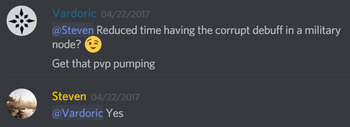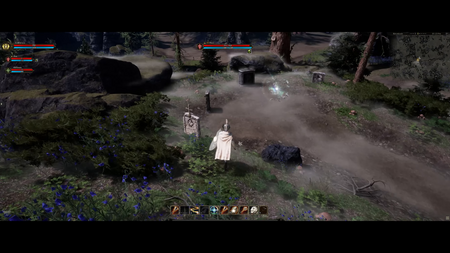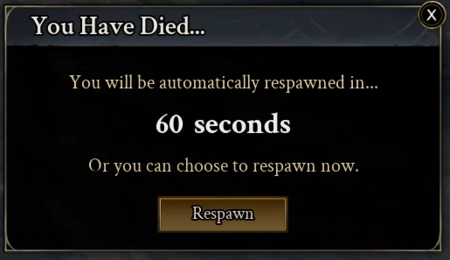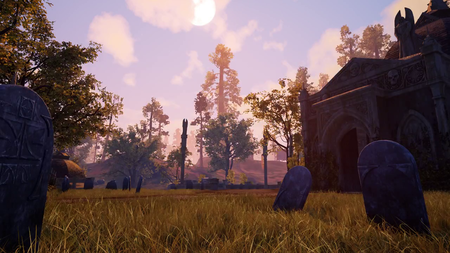| Glorious Wiki readers. We are adding the Midnight Magic video and livestream to the wiki. We appreciate your patience as we process the new and updated information! |
Respawn lore
Il y a un arc narratif qui porte sur comment et pourquoi les personnages ressuscitent ainsi que les lieux dans lesquels ils ressuscitent. Ceci sera révélé tandis que les joueurs explorent le jeu.[2]
Respawn locations
Non-corrupt players always respawn at the closest active respawn point (to their death).[4]
- Corrupt players respawn at random locations in the vicinity of their death, not at regular spawn points.[5]
- There will not be custom respawn points that can be placed in the world.[6]
- Evénements in progress may disable certain respawn points in proximity to those events, which might cause players to respawn further away.[4]
- That has to do with the lore behind death and resurrection and what it means to have your soul connected as a conduit of that spark of life given from the Goddess of Creation, being that phoenix type of avatar; and if corruption has moved into an area and an event has started, the access to those ley line oriented respawn points may be obscured- might not be accessible. So that could create some additional distance that needs to be traveled as part of these types of events.[4] – Steven Sharif
Death penalties
When a player dies they disintegrate into ash. The ashes contain any items lost by the player due to applicable death penalties.[8][9][10][11][12]
- Marquage de joueur is not triggered by looting.[13]
- It might even be the case that their particular bag space doesn't have available location for a three-by-one log; and you're a lumberjack and they see you just chopping down these trees and you're like, there's no point in me engaging with this person, because I have nothing to gain due to my capacity.[16] – Steven Sharif
- There will be a period of time following a player's death before their mule despawns. Other players must kill that player's mule to be able to loot it.[17]
- If the mule dies its corpse will contain the same percentage of lootable items according to the player's death penalties.[17][18]
- Players do not lose gold upon death, no matter their corruption level.[19]
- Glint looted from a dead character by any other player, regardless of affiliation, becomes stolen glint. Character's who loot their own bodies will recover their glint in its non-stolen state.[20][21][9]
Removing corruption
Le principal moyen de retirer la corruption est par la mort. De multiples morts peuvent être nécessaires pour ôter toute la corruption.
- Mourir retire une part significative du score de corruption du joueur.[26]
- Gagner de l'expérience réduira également lentement le score de corruption du joueur.[27]
- Cela crée une expérience plutôt amusante pour les chasseurs de primes qui tentent de vous capturer tandis que vous être en train de la perdre.[27] – Steven Sharif
- Une quête peut être utilisée pour réduire le compte de player kill (PK) d'un joueur corrompu, afin qu'il accumule moins de corruption dans le futur.[28][26]
- Il s'agit d'un changement de design d'un quête religieuse utilisée pour réduire directement le score de corruption.[29]
- La durée de la corruption est réduite dans les noeuds militaires.[30]
Full loot
There will not be a full loot (full drop) system in Ashes of Creation.[31]
There will not be a full drop and the reason for that is because our intention when it comes to progression within the world is we want it to be meaningful and take some investment on behalf of the player; and if even if from a design standpoint we're like yeah but they have to choose to go to the area; we don't want a choice that a player can make where they delete their character so to speak.[31] – Steven Sharif
Voir également
Les références
- ↑ Ashes of Creation Store: Death's Bastion.
- ↑ Podcast, 2018-05-11 (51:39).
- ↑ Vidéo, 2022-12-02 (16:29).
- ↑ 4.0 4.1 4.2 Direct, 2021-06-25 (1:15:37).
- ↑ Entrevue, 2017-04-27 (9:28).
- ↑ Direct, 2023-05-31 (1:08:39).
- ↑ 7.0 7.1 Vidéo, 2024-02-29 (19:35).
- ↑ Direct, 2021-09-24 (51:20).
- ↑ 9.0 9.1 9.2 Direct, 2021-03-26 (1:07:33).
- ↑

- ↑ Podcast, 2017-05-05 (43:05).
- ↑ Entrevue, 2020-07-18 (27:11).
- ↑ Podcast, 2021-04-11 (34:41).
- ↑ Podcast, 2023-07-15 (26:31).
- ↑ Direct, 2023-04-28 (1:18:48).
- ↑ Podcast, 2023-07-15 (28:28).
- ↑ 17.0 17.1 Direct, 2021-01-29 (1:24:27).
- ↑ Direct, 2018-09-27 (47:46).
- ↑

- ↑ Direct, 2023-11-30 (1:52:37).
- ↑ Entrevue, 2023-09-10 (53:47).
- ↑ 22.0 22.1 Direct, 2022-02-25 (1:06:45).
- ↑ 23.0 23.1 Direct, 2022-04-29 (1:08:27).
- ↑ Direct, 2017-07-28 (50:22).
- ↑ Direct, 2018-07-09 (20:41).
- ↑ 26.0 26.1 Entrevue, 2020-07-19 (30:51).
- ↑ 27.0 27.1 Entrevue, 2020-07-18 (44:35).
- ↑

- ↑ Direct, 2018-06-04 (2:18).
- ↑

- ↑ 31.0 31.1 Direct, 2019-07-26 (1:22:50).



